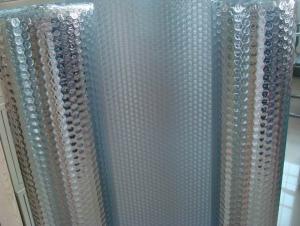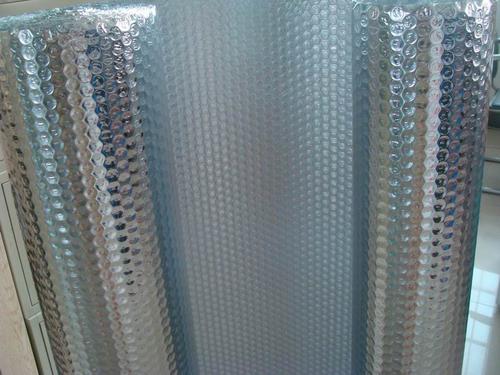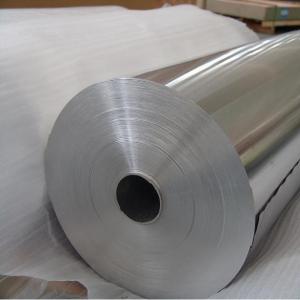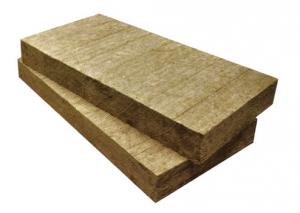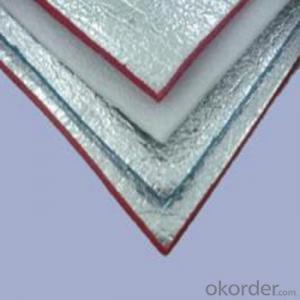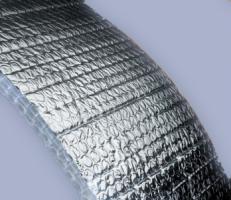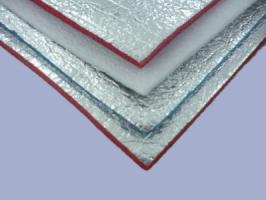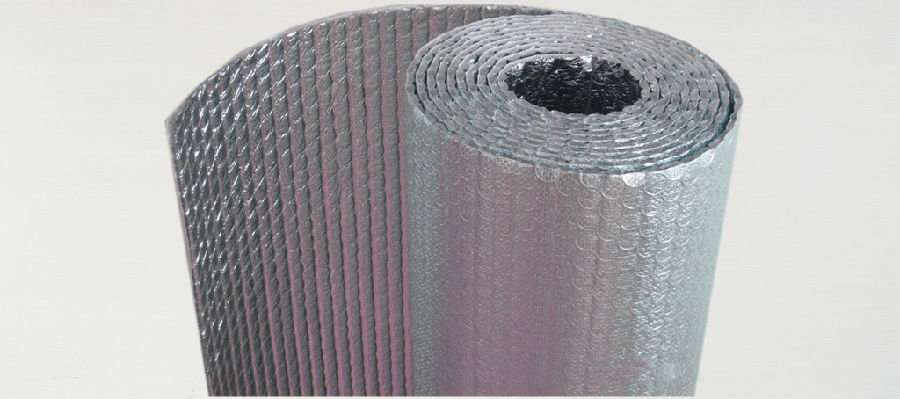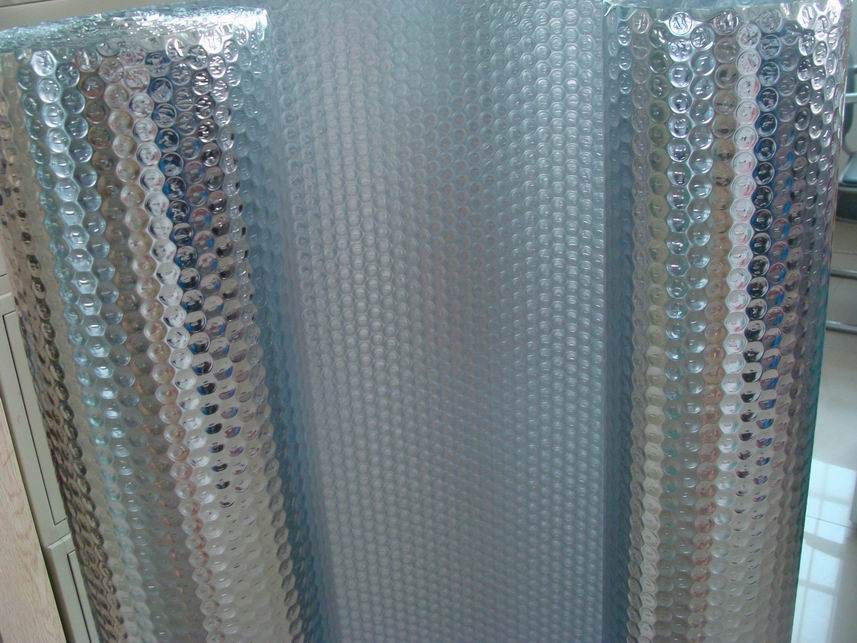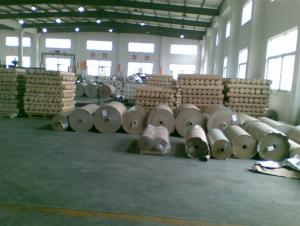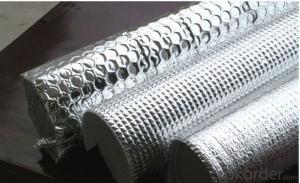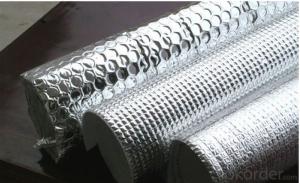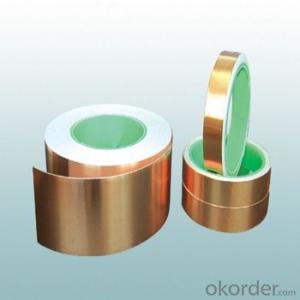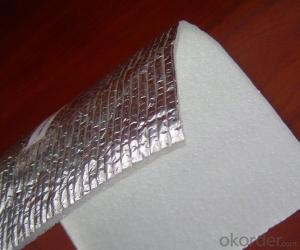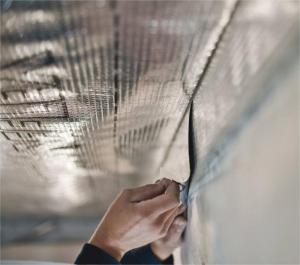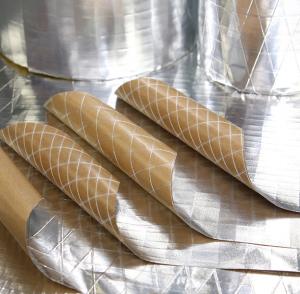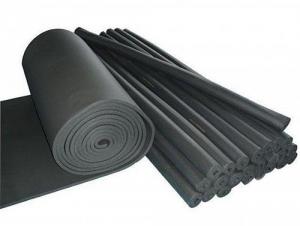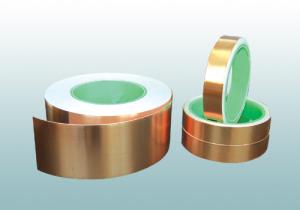Aluminum Foil Facing Bubble Foil Insulation
- Loading Port:
- China Main Port
- Payment Terms:
- TT OR LC
- Min Order Qty:
- -
- Supply Capability:
- -
OKorder Service Pledge
Quality Product, Order Online Tracking, Timely Delivery
OKorder Financial Service
Credit Rating, Credit Services, Credit Purchasing
You Might Also Like
Material Structure: AL/3 way scrim/ADHESIVE
| ||
Paper Weight:60gsm ( Standard, can be Customized) | ||
Roll Size:1.2m*50m ,1.25*50m (can be customized) | ||
PROPERTIES | TEST DATA | UNIT |
Thickness | +-0.15 | mm |
Weight | +-110 | gsm |
Emissivity | 0.03-0.04 | COEF |
Thermal conductivity | 0.037 | w/m0 |
Bursting Strength | 90 | N/25mm |
Reflectivity | 96-97 | % |
Water Vapour Transmission | 1.15 | Ng/N.S |
Corrosion | doesn't generate | |
Tensile Strength(MD) | 144.4 | N/25mm |
Tensile Strength(TD) | 46.3 | N/25mm |
- Q: What are the methods to ensure food does not adhere to aluminum foil while baking?
- <p>To prevent food from sticking to aluminum foil when baking, you can use a few methods. First, lightly grease the foil with cooking spray or oil before placing food on it. Second, consider using a non-stick spray or a light brushing of butter or oil directly on the food itself. Another option is to use parchment paper as a barrier between the food and the foil. Additionally, ensure the food is not overcooked, as this can cause it to stick. Lastly, avoid using shiny, new aluminum foil for acidic or sugary foods as it may react with the foil.</p>
- Q: Is it safe and practical to use aluminum foil facing as a substitute for a kitchen cutting board?
- <p>Using aluminum foil facing as a kitchen cutting board is not recommended. While it may seem like a convenient alternative, it can dull your knives quickly and may not be as sanitary as a proper cutting board. Aluminum foil is also not designed to withstand the pressure and friction of cutting, which could lead to tearing or puncturing the foil, potentially causing injury or contamination. It's best to use a cutting board made from materials like wood, plastic, or bamboo, which are specifically designed for food preparation and cutting.</p>
- Q: Is it possible to use aluminum foil with a reflective surface for storing fruits and vegetables?
- <p>Aluminum foil facing can be used for storing fruits and vegetables, but it's not the best choice. Aluminum foil is not breathable and can cause condensation, leading to spoilage. It's better to use perforated or micro-perforated films that allow for air exchange while keeping light and moisture out. These films help maintain the freshness of produce by slowing down the respiration process and reducing water loss.</p>
- Q: This question is incomplete, but it seems to be asking about special cleaning methods required for a specific situation or item.
- <p>Special cleaning methods can vary greatly depending on the context. For instance, cleaning electronic devices requires anti-static wipes, while cleaning antiques may need gentle, non-abrasive cleaners. In the case of medical equipment, sterilization is crucial. For specific items like carpets, steam cleaning might be necessary. Always refer to manufacturer's instructions or professional guidelines for the best cleaning practices.</p>
- Q: Is it hazardous to cook acidic or salty foods with aluminum foil?
- <p>Using aluminum foil with highly acidic or salty foods is generally safe, but it's important to use the correct type of foil. Heavy-duty aluminum foil is designed for cooking and is safe for use with acidic and salty foods. However, avoid using aluminum foil with reactive metals, as it can cause a chemical reaction. Always follow cooking instructions and be cautious with prolonged cooking times or high temperatures, as these can potentially cause the foil to break down and release small amounts of aluminum into the food. For best results, opt for non-reactive cookware or use parchment paper or silicone baking mats as alternatives.</p>
- Q: Is it safe to use aluminum foil as a liner in a slow cooker, and are there any potential risks or benefits?
- <p>Using aluminum foil as a facing in a slow cooker is generally safe. It can help with easy cleanup and may distribute heat evenly. However, it's important to ensure that the foil doesn't touch the heating element, as this can cause damage to both the foil and the slow cooker. Additionally, while aluminum foil is non-toxic and generally safe, there are concerns about potential leaching of aluminum into food, especially with acidic foods. For health-conscious individuals, using a slow cooker liner made from materials like silicone or stainless steel might be a better alternative.</p>
- Q: Describe the most effective methods for utilizing aluminum foil in cooking.
- <p>Aluminum foil facing can be used effectively in cooking in several ways: 1) As a barrier to prevent food from sticking to the pan or grill, reducing the need for oil or butter. 2) To wrap foods for steaming, which helps retain moisture and flavor. 3) As a cover to keep food warm after cooking or to prevent overcooking. 4) To create packets for cooking fish, vegetables, or other foods en papillote, which steams the food in its own juices. 5) For baking, it can be used to line pans to prevent sticking and to make cleanup easier. 6) Foil can also be shaped into a tent to cover food during the last few minutes of cooking to prevent it from drying out. Always ensure the shiny side of the foil faces inwards when in contact with food to avoid any potential chemical reactions with the food.</p>
- Q: This question asks if there are any potential issues or risks associated with storing food in plastic containers for extended periods.
- <p>Yes, there are concerns about using plastic containers for long-term food storage. Certain plastics can leach chemicals, such as BPA (Bisphenol A) and phthalates, which may be harmful when ingested over time. These chemicals can migrate into the food, especially with exposure to heat or over extended periods. Additionally, plastic containers can break down over time, potentially releasing harmful substances into the food. It's recommended to use food-grade, BPA-free plastics or alternatives like glass containers for long-term storage to minimize health risks.</p>
- Q: This question asks for methods to clean oil stains from the aluminum foil side of a material, likely referring to a type of laminate flooring or backsplash.
- <p>To remove oil stains from aluminum foil facing, first, let the stain dry completely. Then, use a mild detergent mixed with warm water to dampen a cloth and gently wipe the area. Avoid using abrasive cleaners or steel wool, as they can scratch the aluminum foil. For stubborn stains, you may apply a small amount of baking soda paste (baking soda mixed with water) and gently scrub with a soft cloth. Rinse thoroughly with water and dry the area. Always test cleaning methods on a small, inconspicuous area first to ensure no damage occurs.</p>
- Q: This question asks about the various types of aluminum foil facing that can be found in the market.
- <p>Aluminum foil facing is commonly used in construction for insulation and moisture protection. The different types available on the market include: 1) Plain Foil Facing, which is a simple, smooth aluminum surface; 2) Embossed Foil Facing, featuring a textured pattern for added strength; 3) Reinforced Foil Facing, which incorporates additional materials for enhanced durability; 4) Coated Foil Facing, where the aluminum is coated with other substances to improve performance; and 5) Laminated Foil Facing, which combines aluminum with other materials for specific applications. Each type serves different purposes and has unique properties that cater to various construction and industrial needs.</p>
Send your message to us
Aluminum Foil Facing Bubble Foil Insulation
- Loading Port:
- China Main Port
- Payment Terms:
- TT OR LC
- Min Order Qty:
- -
- Supply Capability:
- -
OKorder Service Pledge
Quality Product, Order Online Tracking, Timely Delivery
OKorder Financial Service
Credit Rating, Credit Services, Credit Purchasing
Similar products
Hot products
Hot Searches
Related keywords
